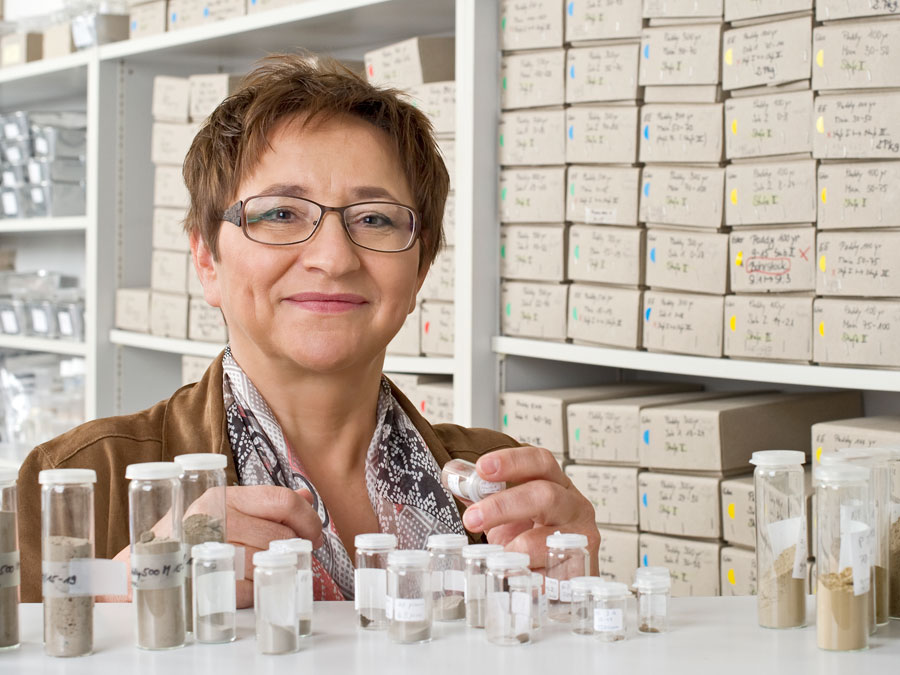Outstanding professors and young scientists honored
Six appointments to Bavarian Academy

Prof. Ingrid Kögel-Knabner
Prof. Ingrid Kögel-Knabner took over the TUM Chair of Soil Science in 1995. She is regarded as a forerunner in the trans-disciplinary orientation of soil sciences. Her work focuses on investigation of the composition and formation of organic substances in soil. In recent years new digital technologies have given soil sciences new possibilities for understanding processes on a micro-scale. Kögel-Knabner and her team perform research on fundamental questions with worldwide relevance. Since much of the most fertile soil available is today being pushed to its limits, the results of this research will ultimately be of service in ensuring the worldwide supply of nutrition.
Kögel-Knabner has conducted research at the Universities in Bayreuth and Bochum. She is a member of the Bioeconomy Council, an advisory board of the German Federal Government. In 2015 she was awarded the Philippe Duchaufour Medal, the highest honor of her discipline.
Prof. Ernst Rank
Prof. Ernst Rank has held the Chair for Computation in Engineering since 1997. One research focus of the Chair is devoted to the close link between geometrical modeling and new numerical calculation methods. This will make computer-driven design processes for engineers faster, more cost-efficient and less prone to error.
Rank received his doctorate in 1985 from the TUM. After a fellowship at the University of Maryland he worked in industry for Siemens and assumed a professorship at the University of Dortmund in 1990. From 2002 to 2008 he served as First Vice-President of the TUM. In 2006 he became the founding director of the International Graduate School of Science and Engineering (IGSSE), and was also Founding Director of the TUM Graduate School from 2008 until 2013. In 2015 he took over as the Director of the TUM Institute for Advanced Study (IAS), which this year celebrates the tenth anniversary of its first fellowships.
Prof. Ulrich Wagner
Prof. Ulrich Wagner conducts research in the areas of improved energy efficiency in plants and buildings, electromobility, the integration of renewable energy sources and energetic lifecycle analyses. The primary focus of the Chair for Energy Economy and Application Technology, to which Wagner was appointed in 1995, is the integrated, empirical observation of energy systems, a topic which has become all the more important in the context of the energy revolution. The objective is achieving systems which are flexible enough to adequately accommodate changes in technical, market-economical, political and societal demands.
Since 1995 Wagner has also been the scientific director of the Research Center for Energy Economics (FfE). Wagner took leave of his post at the TUM from 2010 until 2015, due to his engagement during this period as a director of the German Aerospace Center (DLR), where he was responsible for the areas energy and transport. In 2011 he was appointed a corresponding member of the Bavarian Academy of Sciences and Humanities. He became a full member of the Academy following his return to Bavaria.
Prof. Wolfgang A. Wall
Prof. Wolfgang A. Wall has been Professor for Computational Mechanics at the TUM since 2003. His research focuses on the development of new computational models for application-oriented simulations on high-performance computer systems. These simulations can represent and predict mechanical processes that can not be tested in practice due to their high degree of complexity. Using the high-speed computer "SuperMUC" at the Leibniz data center of the Bavarian Academy of Sciences and Humanities, Wall for example developed a computer model of the human lung which enables improved medical treatment during artificial respiration.
Wall has worked at the universities in Stuttgart and Innsbruck as well as at Princeton University. At TUM he helped establish the Munich School of Engineering (MSE) as a Founding Director; the School consolidates research on "green" technologies. In 2012 Wall received the Computational Mechanics Award of the International Association for Computational Mechanics (IACM).
Junges Kolleg:
Dr. Eva Huber
Dr. Eva Huber is a scientist at the Chair of Biochemistry. Her area of research is the proteasome, a cylinder-shaped enzyme complex in the cell which degrades superfluous and defective proteins. If the proteasome fails to work, the cell drowns in its own refuse. Targeted blocking can damage in particular quickly growing cancer cells and therefore represents a therapy option. In her research project, supported by the Bavarian Academy of Sciences and Humanities, Huber is investigating the structure of the proteasome of the thymus gland, which is essential for the correct development of T-cells.
Dr. Kai Müller
Dr. Kai Müller is a researcher at the Walter Schottky Institute – Center for Nanotechnology and Nanomaterials. He investigates the interactions between light and matter at quantum dots of semiconductor material of only a few nanometers in size. The importance of semiconductor technology stems from the possibility of connecting very large numbers of electronic circuit elements using miniaturization in order to form integrated circuits. The objective of his research project, funded by Bavarian Academy of Sciences and Humanities, is to realize in a similar manner integrated quantum photonic circuits which work based on individual light quanta. Such circuits could be the basis for a new quantum technology with a wide variety of applications, for example in communication, information processing and sensor technologies that are impervious to interception.